Non-Periodic Phenomena in Variable Stars
IAU Colloquium, Budapest, 1968
PHOTOELECTRIC OBSERVATIONS OF 6 SOUTHERN RW AURIGAE
VARIABLES
W. SEGGEWISS and E. H. GEYER
Sternwarte Bonn
A program for investigating the photometric behaviour of RW Aurigae
variables has been started in 1962 by one of the authors (E.H.G.) at the
Boyden Observatory in South Africa. The observations in the UBV colour
system were carried out with the photoelectric equipment of the 60 inch
Rockefeller reflector.
The following six stars classified as RW Aurigae type variables in the
GCVS (1958) have been selected:
Star l^II (1950) b^II
SY Phe 278.5 deg -72.5 deg
SZ Phe 277.5 -71.7
TT Phe 269.7 -71.5
BS Vel 260.0 - 1.5
DI Car 294.9 - 8.6
ES Car 290.7 + 0.2
On the average these stars were measured three times per night during a
total of 8 to 17 nights from 1962 to 1964.
The first four stars show only small changes in magnitude (Fig. 1) and
colours confirming the observations by Hoffmeister (1958) and De Kort
(1941). In Figure 2 the position of these stars in the two colour
diagram is plotted. It seems that SY Phe is an F-Type star in agreement
with the spectral type given in the HD-catalogue (F8) and the Potsdamer
Spektraldurchmusterung (F4). For SZ Phe the PSD gives the spectral type
K4. For the other two stars no spectral types are available. From their
position in the diagram it is concluded that they are also K-type stars.
The star DI Car shows a brightness variation larger than 0.7m in V and
0.3m in B - V, resp. 0.34m in U - B (Fig. 3). The light curve resembles
that of a cepheid star with a period of approximately 30 days. Yet Hoffmeister
(1957) considered this star a member of the CN Ori variables, which are
a subgroup of the U Gem stars. In the Henry Draper Extension the spectrum
of DI Car is characterized as peculiar. We found a weak objective prism
spectrum of this variable on a plate taken by one of us with the duplicate
of the original Schmidt camera at the Boyden Observatory. Because of
the faintness it is almost impossible to associate a correct spectral type.
Three features, however, seem important assuming that they are not simulated
by spots on the plate:
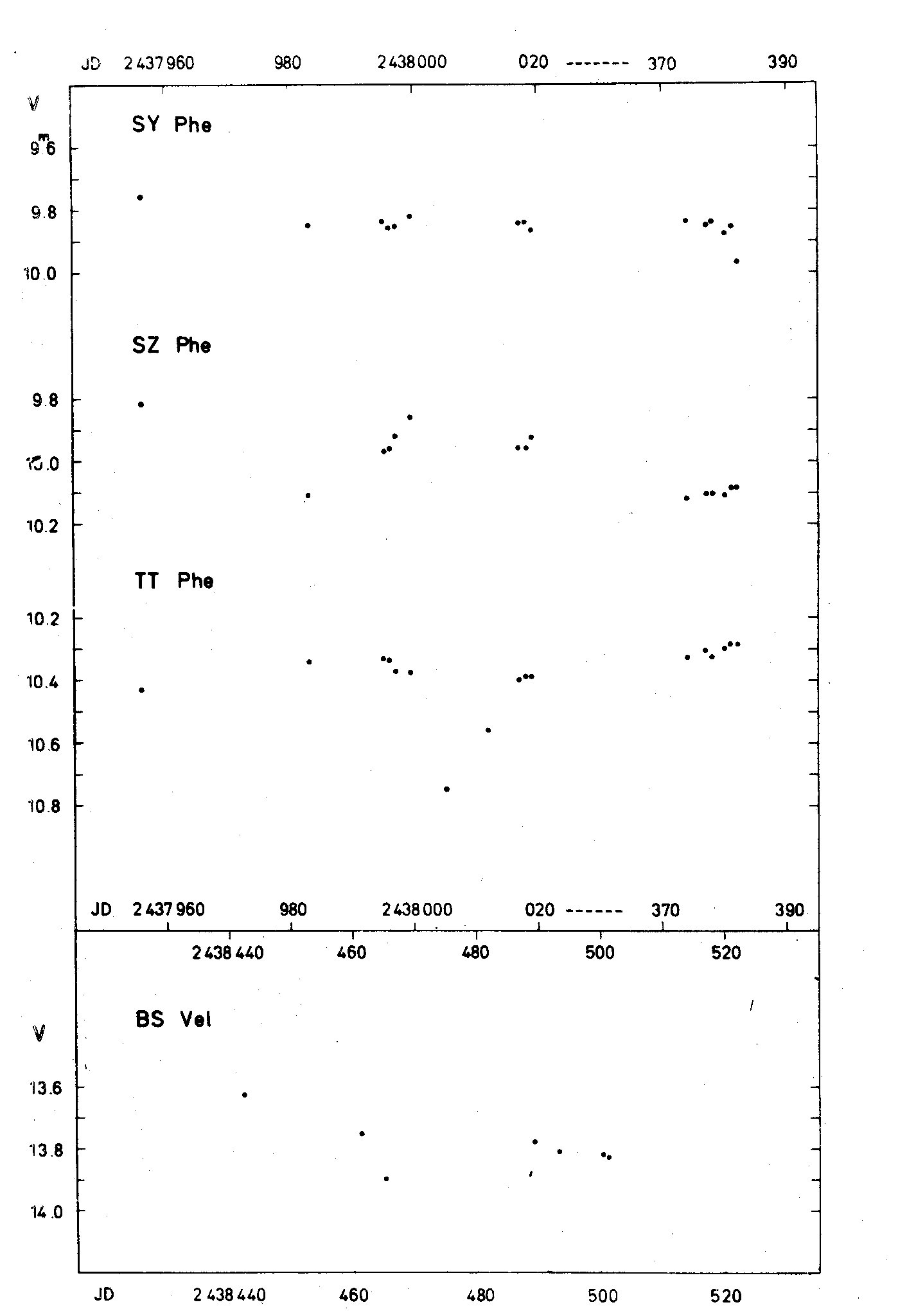 Fig. 1
Fig. 1
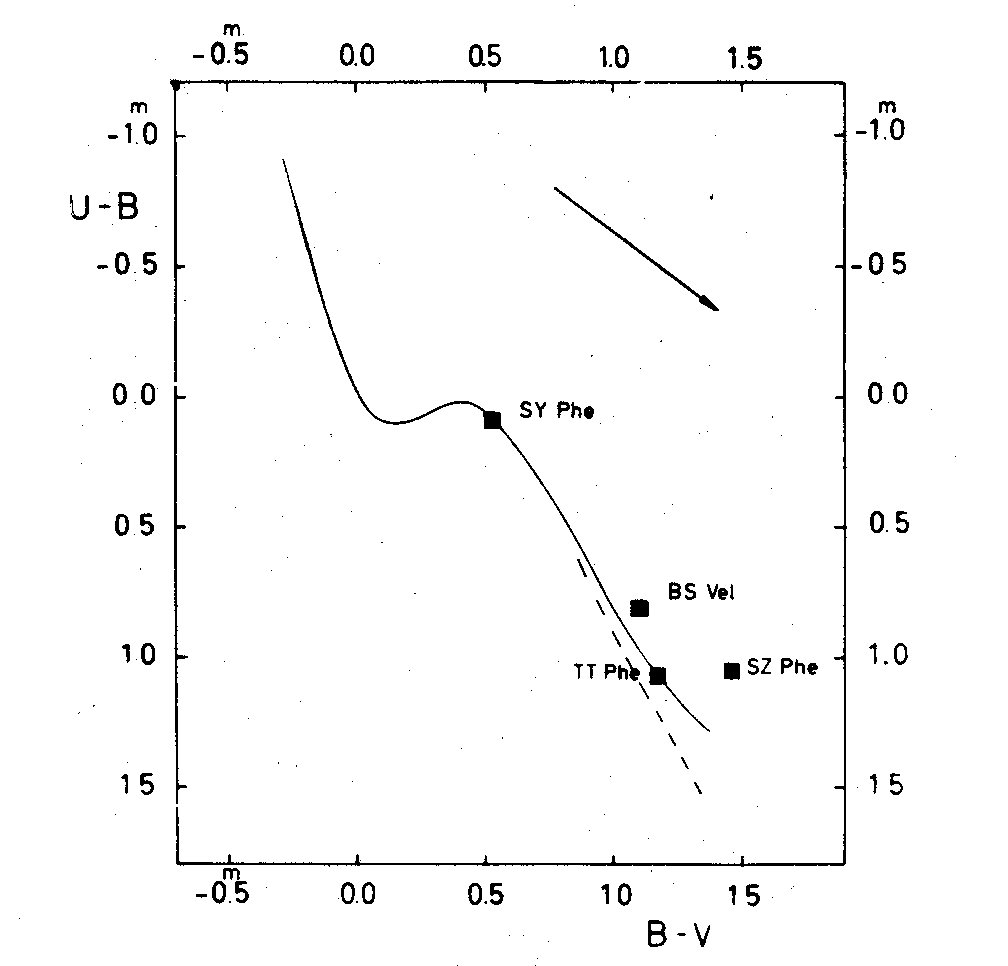 Fig. 2
(1) Sr II 4125 seems absent, as concluded from the undiminished strength
of the continuum in this region.
(2) A strong absorption feature merges into the G-band from the red side;
it may be interpreted as H gamma which is, however, too strong for the
late type apparent from the H and K lines and Ca I.
(3) The continuum between H beta and H gamma is extremely weak. Tentatively
we might assume the star to be a K-dwarf, possibly composite.
During its variations the star moves along a straight line above the
main sequence in the two colour diagram, in the colour magnitude
diagrams the star describes loops (Fig. 4).
It is known through the photographic observations of Hertzsprung
(1925) that the star ES Car shows besides isolated brightness variations
up to 2 magnitudes small and rapid variations of 0.5m, which are
confirmed by our measurements (Fig. 5). In Figure 5 the individual
observations of each night are plotted. The magnitude and colour
differences in the sense variable minus comparison star are given. The
relevant data for the comparison star are: V = 12.78m, B - V = 0.28m,
U - B = 0.14m. This variable is situated close to the galactic plane in
a very rich and complicated portion of the southern Milky Way studied by
Schmidt and Diaz Santanilla (1964). They found in the NW edge of the
open cluster NGC 3572 a second very young cluster located at a larger
distance than NGC 3572 which they designated NGC 3572 b. ES Car lies
close to the centre of this second cluster (star No. 33 in the paper of
Schmidt and Diaz Santanilla). Figure 6 is taken from the above publication.
The variable is shown as a square, filled circles are cluster members, open
circles probable members, and crosses field stars. Assuming ES Car a cluster
member, the following absolute magnitude and intrinsic colours can be derived
Fig. 2
(1) Sr II 4125 seems absent, as concluded from the undiminished strength
of the continuum in this region.
(2) A strong absorption feature merges into the G-band from the red side;
it may be interpreted as H gamma which is, however, too strong for the
late type apparent from the H and K lines and Ca I.
(3) The continuum between H beta and H gamma is extremely weak. Tentatively
we might assume the star to be a K-dwarf, possibly composite.
During its variations the star moves along a straight line above the
main sequence in the two colour diagram, in the colour magnitude
diagrams the star describes loops (Fig. 4).
It is known through the photographic observations of Hertzsprung
(1925) that the star ES Car shows besides isolated brightness variations
up to 2 magnitudes small and rapid variations of 0.5m, which are
confirmed by our measurements (Fig. 5). In Figure 5 the individual
observations of each night are plotted. The magnitude and colour
differences in the sense variable minus comparison star are given. The
relevant data for the comparison star are: V = 12.78m, B - V = 0.28m,
U - B = 0.14m. This variable is situated close to the galactic plane in
a very rich and complicated portion of the southern Milky Way studied by
Schmidt and Diaz Santanilla (1964). They found in the NW edge of the
open cluster NGC 3572 a second very young cluster located at a larger
distance than NGC 3572 which they designated NGC 3572 b. ES Car lies
close to the centre of this second cluster (star No. 33 in the paper of
Schmidt and Diaz Santanilla). Figure 6 is taken from the above publication.
The variable is shown as a square, filled circles are cluster members, open
circles probable members, and crosses field stars. Assuming ES Car a cluster
member, the following absolute magnitude and intrinsic colours can be derived
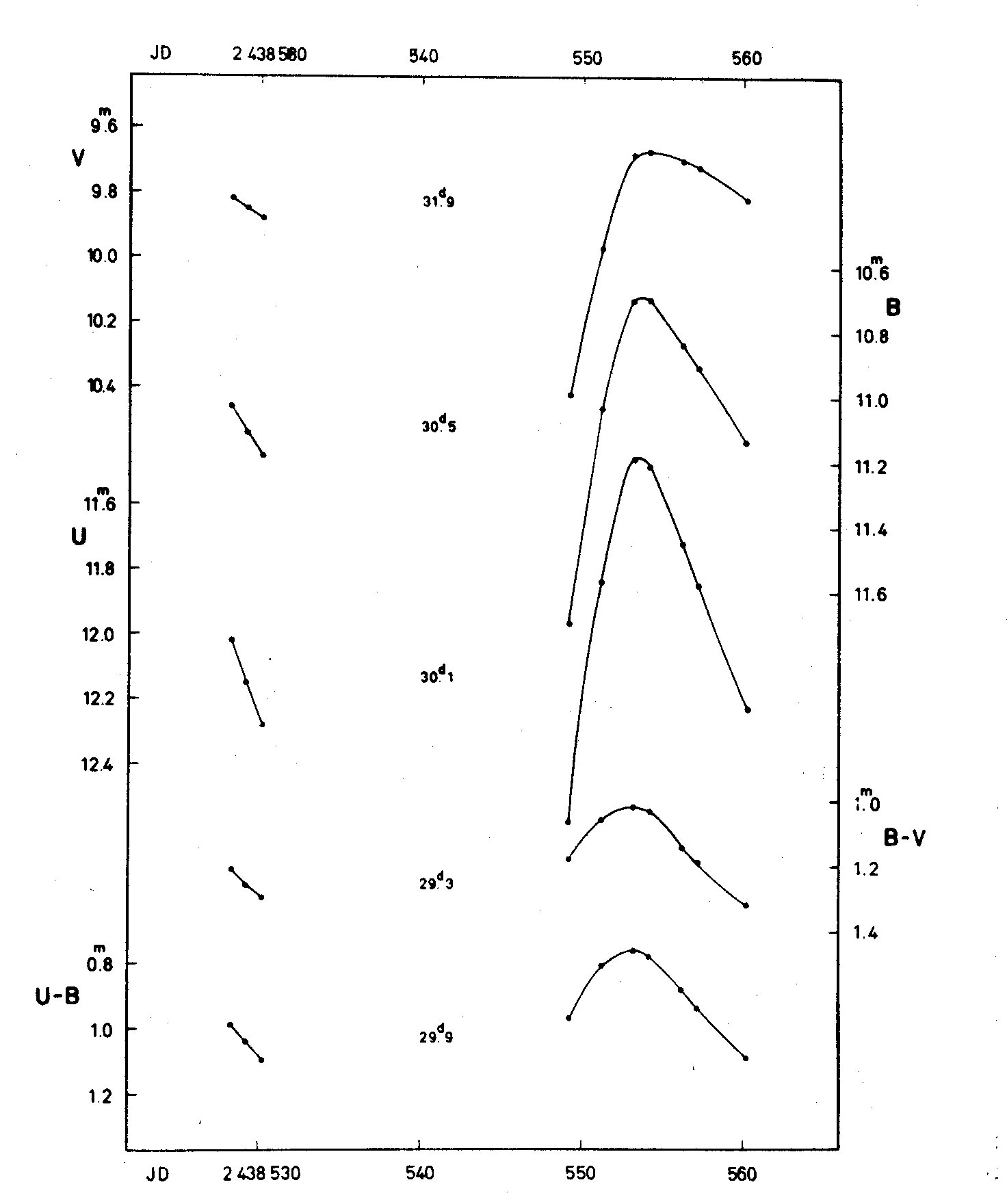 Fig. 3
Fig. 3
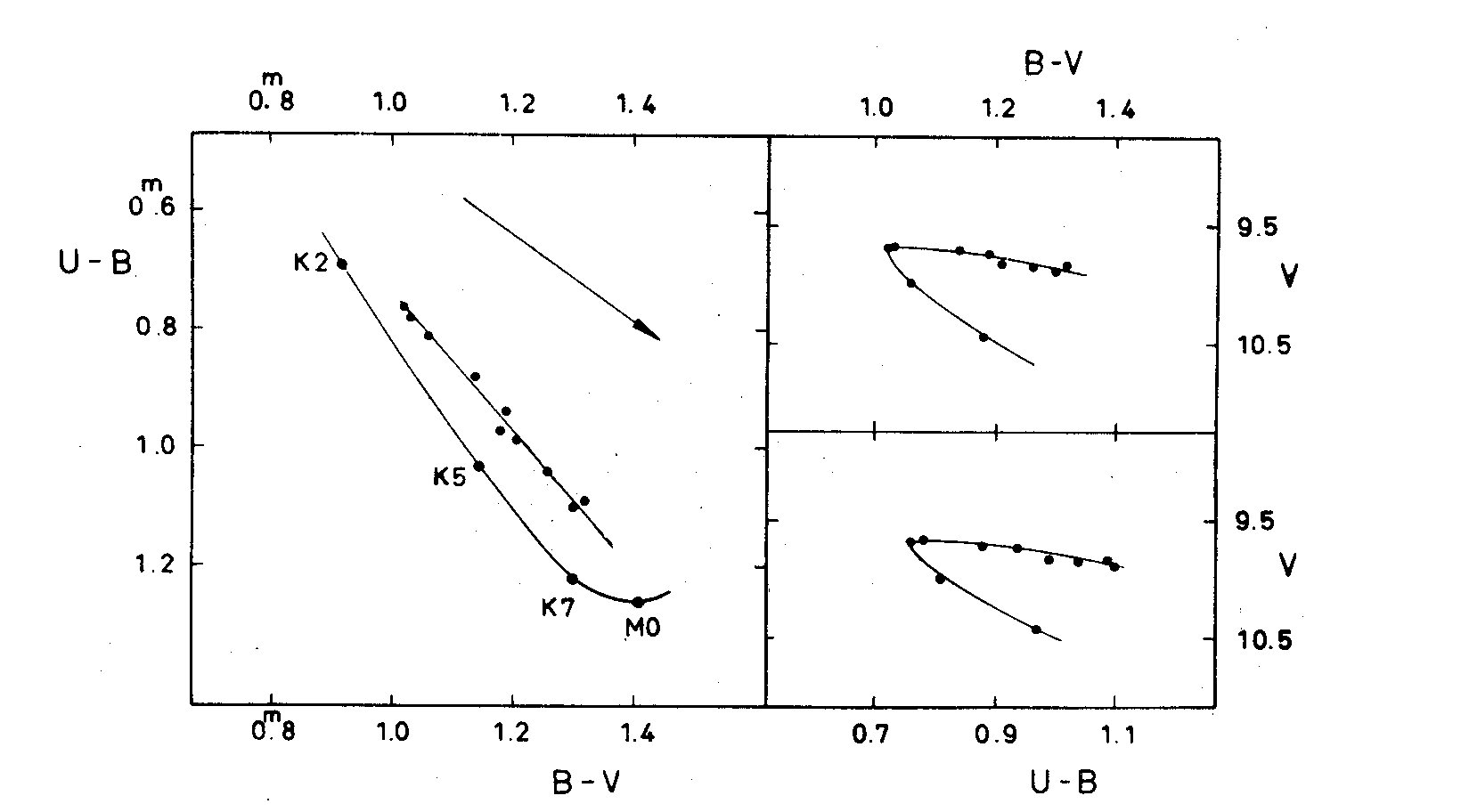 Fig. 4
from the known data of NGC 3572b: M_v = -1.65m, (B -V)_0 = -0.14m,
(U - B)_0 = -0.32m. This corresponds to a B7III star.
The position of the variable in the colour-magnitude diagrams is above
the main sequence indicating the possibility that the star is still in
the contracting phase of its evolutionary track.
In this case NGC 3572b would be the cluster with the earliest not yet to
the main sequence contracted member.
Fig. 4
from the known data of NGC 3572b: M_v = -1.65m, (B -V)_0 = -0.14m,
(U - B)_0 = -0.32m. This corresponds to a B7III star.
The position of the variable in the colour-magnitude diagrams is above
the main sequence indicating the possibility that the star is still in
the contracting phase of its evolutionary track.
In this case NGC 3572b would be the cluster with the earliest not yet to
the main sequence contracted member.
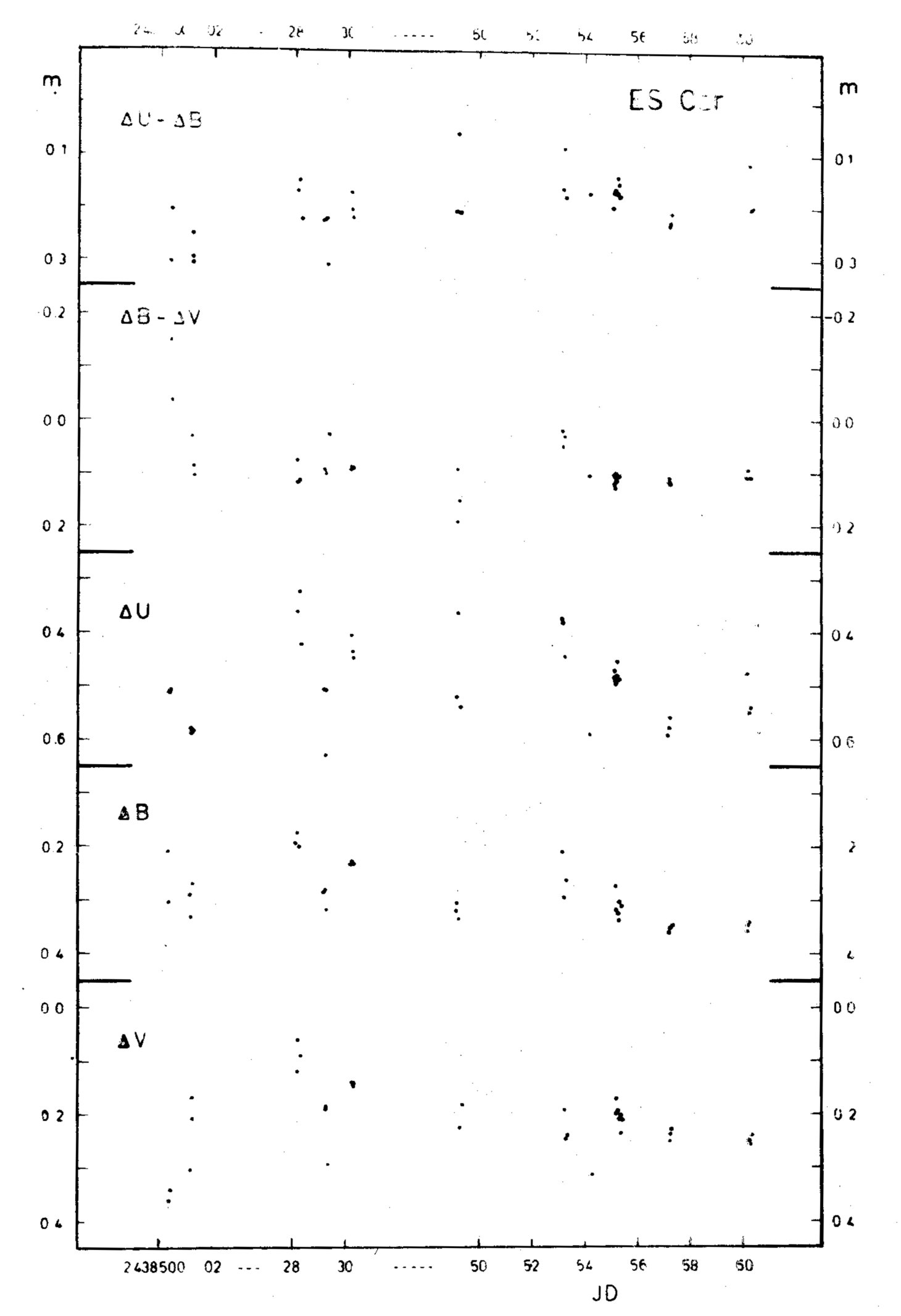 Fig. 5
Fig. 5
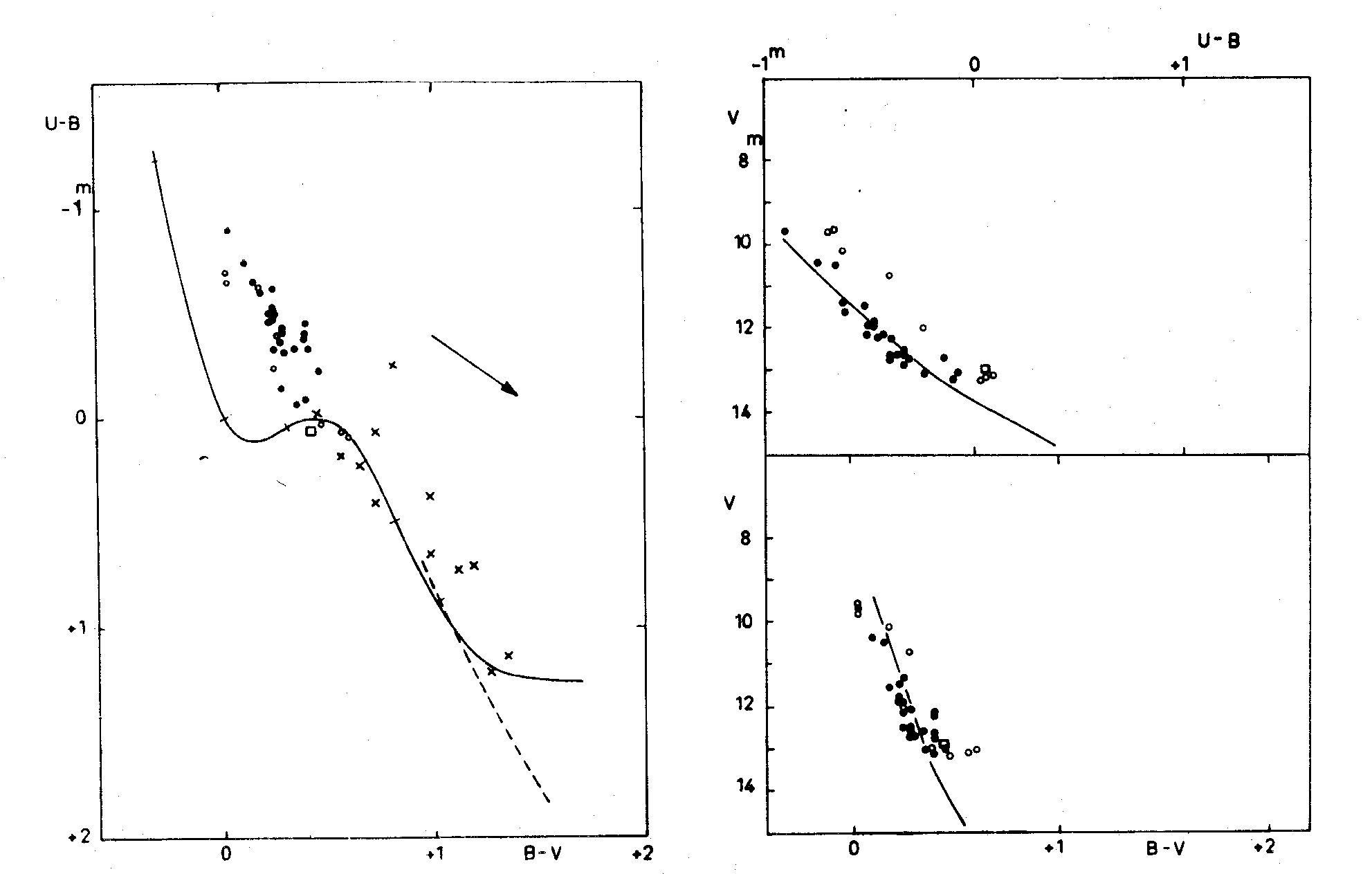 Fig. 6
We are indebted to W. S. Pretorius, former night assistant at Boyden
Observatory, for carrying out most of the photoelectric observations.
REFERENCES
Hertzsprung, E., 1925, Bull. astr. Inst. Netherl. 210.
Hoffmeister, C., 1957, private communication, in Schneller, H., Geschichte und
Literatur des Lichtwechsels der Veränderlichen Sterne, Vol. 4, Berlin.
Hoffmeister, C., 1958, Veröff. Sonneberg 3, 348.
De Kort, J., 1941, Bull. astr. Inst. Netherl. 9, 245.
Kukarkin, B. V. et al., 1958, General Catalogue of Variable Stars, Moscow.
Schmidt, H. and G. Diaz Santanilla, 1964, Veröff. Bonn No. 71.
Fig. 6
We are indebted to W. S. Pretorius, former night assistant at Boyden
Observatory, for carrying out most of the photoelectric observations.
REFERENCES
Hertzsprung, E., 1925, Bull. astr. Inst. Netherl. 210.
Hoffmeister, C., 1957, private communication, in Schneller, H., Geschichte und
Literatur des Lichtwechsels der Veränderlichen Sterne, Vol. 4, Berlin.
Hoffmeister, C., 1958, Veröff. Sonneberg 3, 348.
De Kort, J., 1941, Bull. astr. Inst. Netherl. 9, 245.
Kukarkin, B. V. et al., 1958, General Catalogue of Variable Stars, Moscow.
Schmidt, H. and G. Diaz Santanilla, 1964, Veröff. Bonn No. 71.
 Fig. 1
Fig. 1
 Fig. 2
(1) Sr II 4125 seems absent, as concluded from the undiminished strength
of the continuum in this region.
(2) A strong absorption feature merges into the G-band from the red side;
it may be interpreted as H gamma which is, however, too strong for the
late type apparent from the H and K lines and Ca I.
(3) The continuum between H beta and H gamma is extremely weak. Tentatively
we might assume the star to be a K-dwarf, possibly composite.
During its variations the star moves along a straight line above the
main sequence in the two colour diagram, in the colour magnitude
diagrams the star describes loops (Fig. 4).
It is known through the photographic observations of Hertzsprung
(1925) that the star ES Car shows besides isolated brightness variations
up to 2 magnitudes small and rapid variations of 0.5m, which are
confirmed by our measurements (Fig. 5). In Figure 5 the individual
observations of each night are plotted. The magnitude and colour
differences in the sense variable minus comparison star are given. The
relevant data for the comparison star are: V = 12.78m, B - V = 0.28m,
U - B = 0.14m. This variable is situated close to the galactic plane in
a very rich and complicated portion of the southern Milky Way studied by
Schmidt and Diaz Santanilla (1964). They found in the NW edge of the
open cluster NGC 3572 a second very young cluster located at a larger
distance than NGC 3572 which they designated NGC 3572 b. ES Car lies
close to the centre of this second cluster (star No. 33 in the paper of
Schmidt and Diaz Santanilla). Figure 6 is taken from the above publication.
The variable is shown as a square, filled circles are cluster members, open
circles probable members, and crosses field stars. Assuming ES Car a cluster
member, the following absolute magnitude and intrinsic colours can be derived
Fig. 2
(1) Sr II 4125 seems absent, as concluded from the undiminished strength
of the continuum in this region.
(2) A strong absorption feature merges into the G-band from the red side;
it may be interpreted as H gamma which is, however, too strong for the
late type apparent from the H and K lines and Ca I.
(3) The continuum between H beta and H gamma is extremely weak. Tentatively
we might assume the star to be a K-dwarf, possibly composite.
During its variations the star moves along a straight line above the
main sequence in the two colour diagram, in the colour magnitude
diagrams the star describes loops (Fig. 4).
It is known through the photographic observations of Hertzsprung
(1925) that the star ES Car shows besides isolated brightness variations
up to 2 magnitudes small and rapid variations of 0.5m, which are
confirmed by our measurements (Fig. 5). In Figure 5 the individual
observations of each night are plotted. The magnitude and colour
differences in the sense variable minus comparison star are given. The
relevant data for the comparison star are: V = 12.78m, B - V = 0.28m,
U - B = 0.14m. This variable is situated close to the galactic plane in
a very rich and complicated portion of the southern Milky Way studied by
Schmidt and Diaz Santanilla (1964). They found in the NW edge of the
open cluster NGC 3572 a second very young cluster located at a larger
distance than NGC 3572 which they designated NGC 3572 b. ES Car lies
close to the centre of this second cluster (star No. 33 in the paper of
Schmidt and Diaz Santanilla). Figure 6 is taken from the above publication.
The variable is shown as a square, filled circles are cluster members, open
circles probable members, and crosses field stars. Assuming ES Car a cluster
member, the following absolute magnitude and intrinsic colours can be derived
 Fig. 3
Fig. 3
 Fig. 4
from the known data of NGC 3572b: M_v = -1.65m, (B -V)_0 = -0.14m,
(U - B)_0 = -0.32m. This corresponds to a B7III star.
The position of the variable in the colour-magnitude diagrams is above
the main sequence indicating the possibility that the star is still in
the contracting phase of its evolutionary track.
In this case NGC 3572b would be the cluster with the earliest not yet to
the main sequence contracted member.
Fig. 4
from the known data of NGC 3572b: M_v = -1.65m, (B -V)_0 = -0.14m,
(U - B)_0 = -0.32m. This corresponds to a B7III star.
The position of the variable in the colour-magnitude diagrams is above
the main sequence indicating the possibility that the star is still in
the contracting phase of its evolutionary track.
In this case NGC 3572b would be the cluster with the earliest not yet to
the main sequence contracted member.
 Fig. 5
Fig. 5
 Fig. 6
We are indebted to W. S. Pretorius, former night assistant at Boyden
Observatory, for carrying out most of the photoelectric observations.
REFERENCES
Hertzsprung, E., 1925, Bull. astr. Inst. Netherl. 210.
Hoffmeister, C., 1957, private communication, in Schneller, H., Geschichte und
Literatur des Lichtwechsels der Veränderlichen Sterne, Vol. 4, Berlin.
Hoffmeister, C., 1958, Veröff. Sonneberg 3, 348.
De Kort, J., 1941, Bull. astr. Inst. Netherl. 9, 245.
Kukarkin, B. V. et al., 1958, General Catalogue of Variable Stars, Moscow.
Schmidt, H. and G. Diaz Santanilla, 1964, Veröff. Bonn No. 71.
Fig. 6
We are indebted to W. S. Pretorius, former night assistant at Boyden
Observatory, for carrying out most of the photoelectric observations.
REFERENCES
Hertzsprung, E., 1925, Bull. astr. Inst. Netherl. 210.
Hoffmeister, C., 1957, private communication, in Schneller, H., Geschichte und
Literatur des Lichtwechsels der Veränderlichen Sterne, Vol. 4, Berlin.
Hoffmeister, C., 1958, Veröff. Sonneberg 3, 348.
De Kort, J., 1941, Bull. astr. Inst. Netherl. 9, 245.
Kukarkin, B. V. et al., 1958, General Catalogue of Variable Stars, Moscow.
Schmidt, H. and G. Diaz Santanilla, 1964, Veröff. Bonn No. 71.